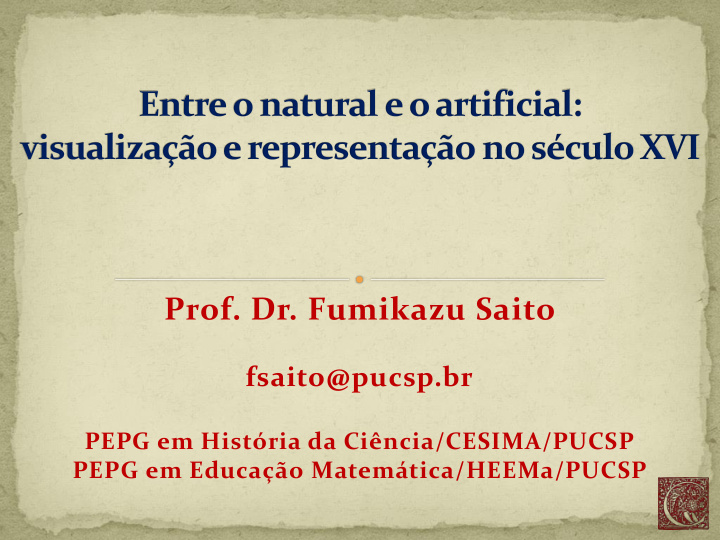



Prof. Dr. Fumikazu Saito fsaito@pucsp.br PEPG em História da Ciência/CESIMA/PUCSP PEPG em Educação Matemática/HEEMa/PUCSP
Ph.D dissertation (2008) Instrumentos de magia e de ciência: a observação mediada em De telescopio segundo a perspectiva de Giambattista della Porta Post-Doc (2009) Forma, elemento e matéria nos três reinos da natureza segundo o corpus physiognomonicus de Giambattista della Porta (1535-1615) Projects (since 2010) Ciência e Techné na primeira modernidade: a transmissão de conhecimentos por meio de textos, instrumentos e imagens A relação entre ciência e techné na magia natural de Girolamo Cardano e Giambattista della Porta
In a recent study we have shown that one cannot establish a clear distinction between studies on optics and on linear perspective in the fifteenth and sixteenth centuries.
Stanford Univesity – Stanford (History and Philosophy of Science and Technology) Università degli studi di Siena (Siena) Museo di Storia della Scienza (Museo Galileo) (Firenze) Biblioteca Nazionale Centrale di Firenze Accademia dei Lincei (Roma) Biblioteca Nazionale Centrale di Napoli (Napoli)
Treatise like Barbaro’s La prattica della perspectiva Purpose teach perspective They were written for an audience who shared ideas related to the manual arts ( artes ) in the sixteenth century Ars which sense does not refer to the fine arts However , we can say that they shared different ideas and established a rich dialogue on the perception of natural reality in the origins of modern science
Evidence of this dialogue can be found in different works published in that period. These works express in different ways the study of perspective, starting with the very distinction between Perspectiva naturalis (or comunnis ) and artificialis We cannot split linear perspective from optics in the sixteenth century. Although perspectiva artificialis dealt with geometric representation of objects, it was closely associated to issues concerning vision
Optics in the Sixteenth Century It was not simply a chapter of physics with features essentially mathematical and physical It also dealt with the effects of physical stimuli in sensory organ of vision and the consequent perception of such stimuli which were perceived by the soul Optics in this sense was a “science of vision” The term “ perspectiva ” as Latin translation of Greek word “ optikè ” Optikè : meant direct and distinct vision
Euclid, Optics Pecham, Perspectiva Communis Risner, Opticae thesaurus Pélerin (Viator), De artificiali perspective Caus, La perspective (...) Many other titles: De aspectibus ... [reference to the problems of visual appearance, the appearance or shape of things as they appeared to the eye] Arabic treatises (nine through twelfth centuries) De visu ... [designates only the sense of sight in regard to vision problems and evidence of sensible things]
From sixteenth century onward: Gradual separation of these two kind of “optics” ( perspectiva ) Although aspects of vision still remain, others related to the physiology and anatomy are put aside. Some treatises gradually give greater importance to light, others to issues related to the shadow. The issues concerning anatomical and physiological aspects of vision gradually disappear, migrating to treatise related to medicine or physics . La pratica della perspettiva (1596) by Daniele Barbaro Livre de perspective (1560) by Jean Cousin La perspective (1611) by Salomon de Caus
La pratica della perspettiva (1596)
Livre de perspective (1560)
La perspective (1611)
La pratica della perspettiva (1596) "... We have to consider not only what eye sees, but also how it sees ...“ (Book I, Chap. I) Chapter II, Barbaro made a distinction between: “ simple look and see ” “ careful and acute vision ” (natural vision) (modes of vision) “ That does not matter whether vision is given by reception or transmission of visual rays ” (Euclid Optics )
Refraction into the eye
It is evident the influence of the ideas contained in Euclid’s Optics in Barbaro’s treatise... However other aspects related to vision are also present…
Distinction between (in Aristotelian fashion) “natural and mathematical angle of vision ”: Natural line and angle could not be divided ad infinitum Mathematical line and angle could be divided ad infinitum Barbaro concludes that perspective takes into account the ratio of natural signals, lines and angles
Perspective as mixed-mathematics (natural – geometrical) Barbaro’s treatise on the one hand approaches and on the other, differs from traditional treatise of perspectiva Two important points: Eye is reduced to a point Refractions into the eye are eliminated Pyramid and not a cone of vision (The base is a square ,not a circle)
Thank you very much! fsaito@pucsp.br http://fumikazusaito.com
Recommend
More recommend